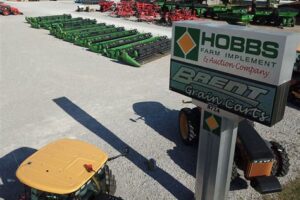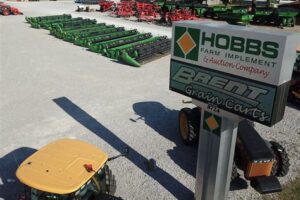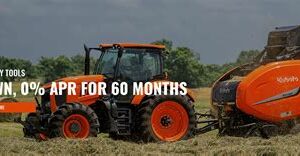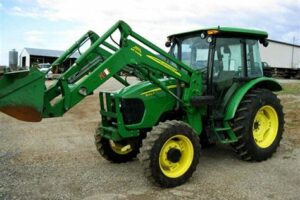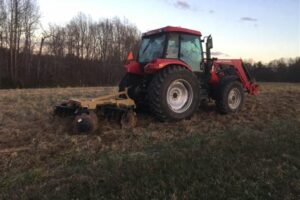Table of Contents
Discover the evolution of farm equipment in the 1800s, a time when innovation revolutionized agricultural practices. From the advent of steam power to the introduction of reapers and threshers, explore how these advancements transformed farming and increased productivity. Dive into the fascinating history of early farm machinery and gain a deeper understanding of the tools that helped shape the modern agricultural industry.
In the 1800s, farming was a way of life for many Americans. However, the tools and equipment used on farms during this time were quite different from what we see today. From the simple plow to the revolutionary reaper, farm equipment in the 1800s played a crucial role in shaping agriculture as we know it. Transitioning from manual labor to mechanized farming, these inventions brought about significant changes in productivity, efficiency, and ultimately, the growth of the agricultural industry.
Farm Equipment in the 1800s
The 19th century marked a significant shift in agricultural practices, thanks to the advent of new and improved farm equipment. This era witnessed a transformation in farming methods, as manual labor was gradually replaced by machines. This article delves into the key types of farm equipment that revolutionized the industry during the 1800s.
The Plow
One of the most vital tools of the 1800s was the plow. Traditionally, plows were made entirely from wood, but innovations in metallurgy allowed for the creation of iron and steel plows. These new materials greatly enhanced the durability and effectiveness of this essential farm implement. Farmers could now cultivate larger areas of land with greater speed and efficiency.
The Reaper
Prior to the reaper’s invention, harvesting crops was a labor-intensive process. The mechanical reaper, introduced in the early 1800s, transformed the way farmers harvested grain. It allowed for the mechanization of cutting and gathering crops, significantly reducing the time and effort required. This invention revolutionized agriculture by increasing productivity and making it easier for farmers to meet the growing demand for food.
The Thresher
Once crops were harvested, the next challenge was separating the grain from the chaff. The invention of the thresher in the 1780s provided a solution to this problem. Initially powered by horses or hand-cranked, threshers eventually transitioned to steam power. This machine mechanized the process of separating grain from its surrounding husk, streamlining post-harvest operations and increasing overall efficiency.
The Steam Engine
One of the most transformative inventions of the 1800s was the steam engine. While not exclusively used for farming, steam engines played a crucial role in powering various farm equipment. They enabled the mechanization of tasks such as plowing, threshing, and milling, greatly reducing the reliance on manual labor. With steam engines, farmers could achieve higher levels of productivity and cultivate more extensive areas of land.
The Grain Drill
The grain drill was a significant innovation that improved the efficiency of planting crops in the 1800s. Before its invention, seeds were often sown by hand, resulting in uneven distribution and wasted resources. The grain drill mechanized the planting process, ensuring a consistent spacing and depth for each seed. This technology facilitated more efficient use of seeds and significantly improved crop yields.
The Mower
Mowing large fields of grass was a laborious task until the introduction of the mechanical mower. This invention enabled farmers to quickly and efficiently cut grass for animal feed or hay production. Initially horse-drawn and later powered by steam engines, mowers revolutionized the farming industry by reducing the time and effort required for this essential task.
The Hay Rake
After cutting grass, farmers needed a way to gather and bundle it for storage or feeding. The hay rake was designed precisely for this purpose. This machine efficiently collected and raked hay into windrows, facilitating the drying process. With the hay rake, farmers could gather larger quantities of hay more efficiently, ensuring a steady supply of fodder for their livestock.
The Corn Sheller
Corn was a staple crop in the 1800s, but removing the kernels from the cob was a time-consuming task. The corn sheller revolutionized this process by mechanically separating the corn kernels from the cob. Initially operated manually, corn shellers eventually transitioned to mechanical and steam-powered machines. This invention greatly increased the efficiency of processing corn, making it easier for farmers to meet the demand for this essential food source.
The Threshing Machine
The threshing machine was a critical advancement in the agricultural industry. It mechanized the process of separating grain from harvested stalks, eliminating the need for manual beating or flailing. Threshing machines were initially powered by horses, but later models were steam-powered. This invention revolutionized the grain harvesting process, greatly reducing labor requirements and increasing overall efficiency.
In conclusion, the 1800s witnessed remarkable advancements in farm equipment that transformed the agricultural industry. Innovations such as the plow, reaper, thresher, steam engine, grain drill, mower, hay rake, corn sheller, and threshing machine revolutionized farming practices. These machines increased productivity, reduced labor demands, and allowed farmers to cultivate larger areas of land more efficiently. The introduction of these farm equipment paved the way for modern-day agriculture, shaping the industry as we know it today.
Introduction to Farm Equipment in the 1800s
In the 1800s, farming underwent a significant transformation due to the development of various types of farm equipment. These innovations aimed to increase efficiency, productivity, and reduce the labor-intensive nature of agricultural practices. This article explores the key advancements in farm equipment during this era.
Plows: Revolutionizing Ground Preparation
Plows played a crucial role in revolutionizing ground preparation during the 1800s. The introduction of the steel plow by John Deere in 1837 greatly enhanced the capability of farmers to break up the tough prairie soil and prepare it for planting. The steel plow proved to be more durable, efficient, and easier to handle, making it an essential tool for farmers during this time.
Seed Drills: Enhanced Precision in Planting
Seed drills were another breakthrough in 19th-century farm equipment. Instead of manual planting by hand, seed drills allowed farmers to plant seeds in a more controlled and consistent manner. Jethro Tull’s horse-drawn seed drill, invented in 1701 but widely used during the 1800s, ensured that seeds were placed at a precise depth and spacing, leading to improved crop yields.
Reaper: Revolutionizing Harvesting Techniques
The invention of the mechanical reaper by Cyrus McCormick in 1831 transformed the way crops were harvested in the 1800s. The reaper replaced traditional manual harvesting methods by using sharp blades and a mechanical mechanism to efficiently cut and gather crops such as wheat. By automating this labor-intensive task, the reaper vastly increased productivity and reduced the need for manual labor on farms.
Threshing Machines: Streamlining Grain Separation
Threshing machines were introduced in the 1800s to streamline the process of separating grain from its stalks. Previously, this task was done manually, but with the advent of threshing machines, farmers could save considerable time and effort. These machines used a combination of rotating drums and beaters to separate the grain, making it a significant advancement for the agricultural industry.
Mowers: Efficient Grass Cutting Mechanisms
Prior to the invention of mowers, farmers relied on scythes to manually cut grass, which was a labor-intensive and time-consuming process. In the 1800s, mechanical mowers became popular, driven by either horses or steam power, allowing for faster and more efficient grass cutting. These mowers could cover larger areas of land in a shorter time, enabling farmers to maintain pastures and hay fields more easily.
Threshing and Separating Machines: Grain Processing Made Easier
Threshing machines were further improved in the 1800s with the addition of separating machines. These machines, often combined with threshers, helped farmers easily separate and clean grain after the initial threshing process. By eliminating impurities such as chaff and dust, separating machines enhanced the quality of harvested grain and reduced manual labor requirements, making them indispensable on farms.
Steam Engines: Powering Agricultural Machinery
The introduction of steam engines in the 1800s revolutionized how farm equipment was powered. These engines allowed for the development of larger and more powerful farming machinery, such as steam-powered tractors. Steam engines provided a reliable and consistent power source, increasing the efficiency and capacity of agricultural operations.
During the 1800s, farm equipment underwent significant advancements that revolutionized agricultural practices. These developments played a crucial role in increasing productivity, improving efficiency, and ultimately transforming the farming industry as a whole. In this article, we will explore the various aspects of farm equipment in the 1800s, highlighting their impact and significance.
1. Introduction of Mechanical Innovations
One of the most notable transformations in farm equipment during the 1800s was the introduction of mechanical innovations. This period witnessed the emergence of numerous groundbreaking inventions that replaced traditional manual labor with machinery. Farmers began to rely on steam engines, tractors, and threshing machines to perform tasks that were previously done by hand. These advancements resulted in significant time and energy savings, allowing farmers to cultivate larger areas of land more efficiently.
2. Impact on Crop Production
The adoption of farm equipment in the 1800s had a profound impact on crop production. The introduction of mechanized plows, seed drills, and reapers allowed farmers to cultivate and harvest crops on a much larger scale. These machines not only increased the speed of planting and harvesting but also ensured greater precision and uniformity. As a result, farmers were able to produce larger quantities of crops, leading to improved food security and economic growth.
3. Advancements in Transportation
Farm equipment in the 1800s also played a crucial role in advancing transportation systems. The development of steam-powered locomotives and agricultural wagons equipped with iron wheels allowed farmers to transport their crops and goods over longer distances. This facilitated the growth of regional and national markets, enabling farmers to expand their customer base and access better prices for their produce. Additionally, improved transportation systems also led to the diversification of crops, as farmers could now transport perishable goods more efficiently.
4. Changes in Labor Dynamics
The introduction of farm equipment in the 1800s brought about significant changes in labor dynamics. With the adoption of machinery, farmers required fewer manual laborers to carry out farming tasks. This led to a decline in the dependence on human workers and a shift towards a more mechanized workforce. While this resulted in job losses for some, it also created new employment opportunities in industries related to manufacturing and maintaining farm equipment.
5. Challenges and Limitations
Despite the numerous benefits that farm equipment brought during the 1800s, there were also challenges and limitations associated with these advancements. The initial cost of purchasing machinery was often high, making it inaccessible to smaller farmers. Furthermore, the maintenance and repair of these machines required specialized skills and knowledge, which added additional costs for farmers. Additionally, the transition from traditional farming practices to mechanization required farmers to adapt and learn new techniques, presenting a learning curve for many.
6. Overall Impact and Legacy
The introduction of farm equipment in the 1800s had a transformative impact on the agricultural industry. It revolutionized farming practices by increasing productivity, improving efficiency, and expanding market access. These advancements laid the foundation for modern agriculture, shaping the way we cultivate crops and manage farms today. The legacy of the farm equipment innovations from the 1800s can still be seen in the advanced machinery and technologies used in contemporary farming.
In conclusion, the development and adoption of farm equipment in the 1800s brought about significant changes in the agricultural sector. These mechanical innovations revolutionized crop production, transportation systems, and labor dynamics. Despite challenges and limitations, the overall impact of farm equipment in the 1800s continues to shape modern farming practices and contribute to global food production.
Thank you for taking the time to visit our blog and explore the fascinating world of farm equipment in the 1800s. We hope that you have found this journey through history both educational and enlightening. As we wrap up this article, let us reflect on the importance of these tools and their impact on agriculture during this era.
During the 1800s, advancements in farm equipment revolutionized the way farmers worked their land. The transition from manual labor to mechanization brought about a significant increase in productivity and efficiency. This period saw the birth of several crucial inventions that shaped the future of farming.
One of the most notable advancements was the introduction of the steel plow by John Deere in 1837. This innovation allowed farmers to break through tough, compacted soil with ease, making it possible to cultivate previously inaccessible land. The steel plow became a game-changer in agriculture, enabling farmers to significantly increase their crop yields and ultimately contributing to the growth of the agricultural industry.
Another pivotal invention was the reaper, patented by Cyrus McCormick in 1834. The reaper mechanized the process of cutting and harvesting crops, reducing the labor-intensive nature of this task. This invention not only saved countless hours of labor but also increased the speed and efficiency of harvesting, allowing farmers to cover larger areas in less time.
In conclusion, the farm equipment developed during the 1800s played a crucial role in shaping the agricultural landscape of that era. These innovations revolutionized farming practices, increasing productivity, and efficiency while reducing manual labor. The steel plow and the reaper were just two examples of the many groundbreaking inventions that changed the face of agriculture forever.
We hope that this glimpse into the past has provided you with a deeper appreciation for the hard work and ingenuity of those who came before us. The advancements made during the 1800s paved the way for modern farming techniques and the machinery we rely on today. Remembering our agricultural roots is essential as we continue to innovate and strive for a sustainable future in the field of agriculture.
Thank you once again for visiting our blog, and we hope to see you soon for more exciting discussions on the history and evolution of farm equipment.
Video Farm Equipment In The 1800s
People also ask about farm equipment in the 1800s, and here are some commonly asked questions along with their answers:
-
What types of farm equipment were used in the 1800s?
In the 1800s, farmers relied on a range of tools and machinery to aid them in their agricultural activities. Some common types of farm equipment used during this time included:
- Plows: Various types of plows were used, such as the wooden moldboard plow and iron plows.
- Harvesters: Manual harvesters were used for grain crops, while scythes and sickles were employed for cutting hay.
- Threshers: These machines were used to separate grains from their stalks or husks.
- Reapers: Horse-drawn reapers were used to efficiently cut and collect crops like wheat.
- Seed drills: These tools helped plant seeds in a systematic manner, improving crop yield.
-
How did farm equipment change during the 1800s?
Farm equipment underwent significant changes throughout the 1800s due to technological advancements and innovations. The use of steam power and later gasoline engines revolutionized farming practices. Steam-powered machinery, such as steam tractors and threshing machines, gradually replaced traditional horse-drawn equipment. Additionally, advancements in iron and steel manufacturing allowed for more durable and efficient implements.
-
What challenges did farmers face with their equipment in the 1800s?
While farm equipment in the 1800s provided valuable assistance to farmers, it also presented certain challenges. Maintenance and repair of machinery were major concerns, as breakdowns could significantly hinder productivity. Farmers often had to rely on their own mechanical skills or local blacksmiths to fix equipment issues. Additionally, the initial cost of purchasing new machinery could be burdensome for some farmers, especially those with limited resources.
-
How did farm equipment impact agricultural productivity in the 1800s?
The introduction of advanced farm equipment greatly improved agricultural productivity in the 1800s. With the use of machinery, farmers could cultivate larger areas of land, increase crop yields, and reduce the time and labor required for various tasks. This, in turn, led to increased food production and supported the growing population during the Industrial Revolution.
-
What were the limitations of farm equipment in the 1800s?
Despite the advancements, farm equipment in the 1800s had its limitations. The machinery was often heavy and difficult to maneuver, particularly in hilly or uneven terrain. Moreover, the lack of standardization made it challenging to repair or replace broken parts, as each machine had unique specifications. Farmers also had to contend with weather conditions that could affect the performance and efficiency of their equipment.
I hope these answers provide you with valuable insights into farm equipment used in the 1800s!

